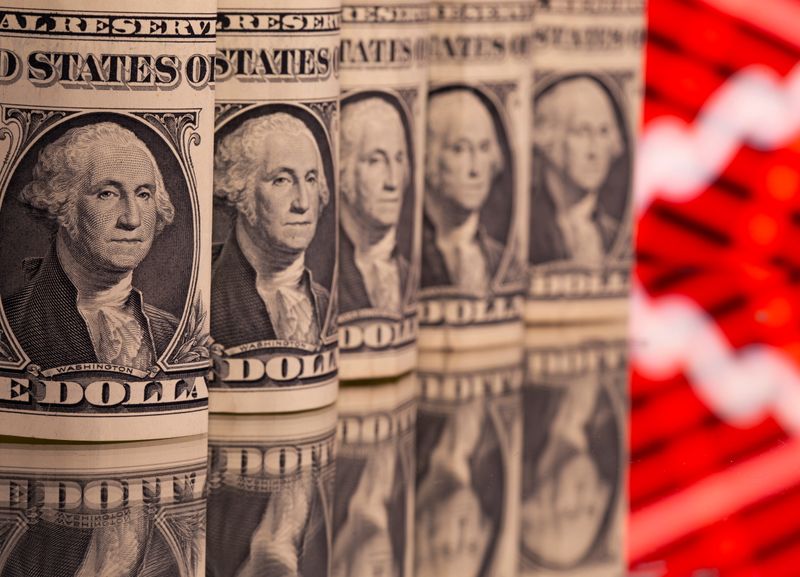By Karen Brettell
NEW YORK (Reuters) – The dollar index slipped while the euro was steady on Thursday in choppy trading as investors awaited Federal Reserve Chairman Jerome Powell’s speech on Friday for further clues about the pace of the U.S. central bank’s rate hikes.
Investors are tossing up between the likelihood of a 50 or 75 basis point rate increase in September as the Fed battles inflation while facing some softer U.S. economic data.
“It seems to me that markets are maybe expecting a hawkish message from Powell,” said Shaun Osborne, chief FX strategist at Scotiabank in Toronto.
However, “since the last FOMC the numbers out of the U.S. have not really been all that good. I think with gasoline prices in the U.S. coming down quite significantly there is the view that inflationary pressures may well have peaked,” Osborne said.
Fed officials on Thursday were noncommittal about the size of the rate hike they will approve at their Sept. 20-21 meeting, but continued hammering the point they will drive rates up and keep them there until inflation has been tamed.
“The only dovish element that is immediately up for debate is incremental policy changes to fed funds at upcoming meetings,” Alan Ruskin, macro strategist at Deutsche Bank (ETR:DBKGn), said in a note on Thursday.
However, “even here, do not expect Powell to resolve the 50 bp versus 75 bp debate for the September meeting,” Ruskin said, noting that the Fed will want to see August’s jobs and inflation data before making a decision.
Fed funds futures traders are pricing in a 65% chance of a Fed rate hike of another 75 basis points at its September meeting, and a 35% probability of a 50 basis points increase.
The dollar index fell 0.14% to 108.46. It is holding just below a 20-year high of 109.29 reached in on July 14.
The currency edged higher after data on Thursday showed the U.S. economy contracted at a more moderate pace than initially thought in the second quarter.
The euro was unchanged against the greenback on the day at $0.9968.
The single currency briefly rose back above parity overnight, before retracing after the release of a closely watched index showing business morale in Germany in August had fallen to its lowest since June 2020.
European Central Bank policymakers meeting last month appeared increasingly concerned that high inflation was getting entrenched, even as the risk of a recession loomed in the bloc, the accounts of the July 21 meeting showed on Thursday.
The euro/dollar’s direction this week has largely been driven by soaring natural gas prices, which are correlated with a weaker euro because of the region’s dependence on gas for its energy needs. That, plus worries about the global economy had sent investors into dollars earlier this week.
The Australian dollar was lifted after a Chinese state media report said China would take more steps to support the economy, including increasing funding support for infrastructure projects and ramping up support for private firms and technology companies.
The Aussie gained 1.01% to $0.6976.
China’s yuan also rebounded from a two-year low against the dollar as official guidance was set at a firmer-than-expected level.
Market participants said the guidance could be a sign that authorities are becoming increasingly uncomfortable with rapid losses in the yuan, which has fallen about 1.6% against the dollar so far in August.
“How the yuan performs can at the margin affect how the dollar trades more broadly against the majors, so that’s something to certainly keep an eye on in the short run at least,” said Osborne.
The dollar dipped 0.15% against the Chinese currency to 6.8477.
The greenback also fell 0.47% against the Japanese yen to 136.47.
The Bank of Japan must maintain massive monetary stimulus and its dovish policy guidance until wages show clearer signs of increasing, one of its board members said, reinforcing the central bank’s outlier status in a global wave of monetary tightening.



